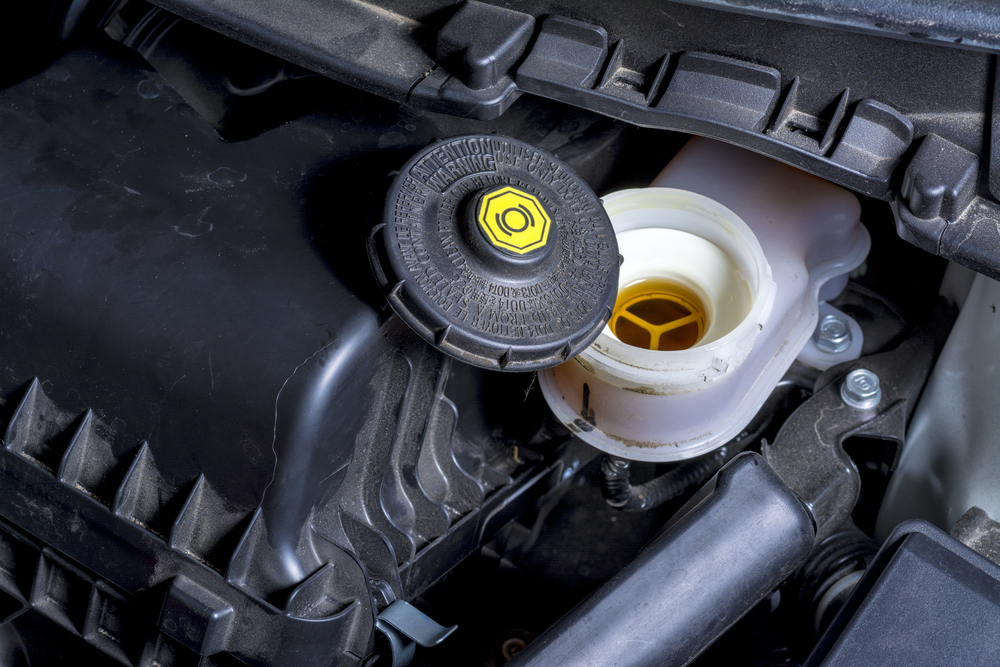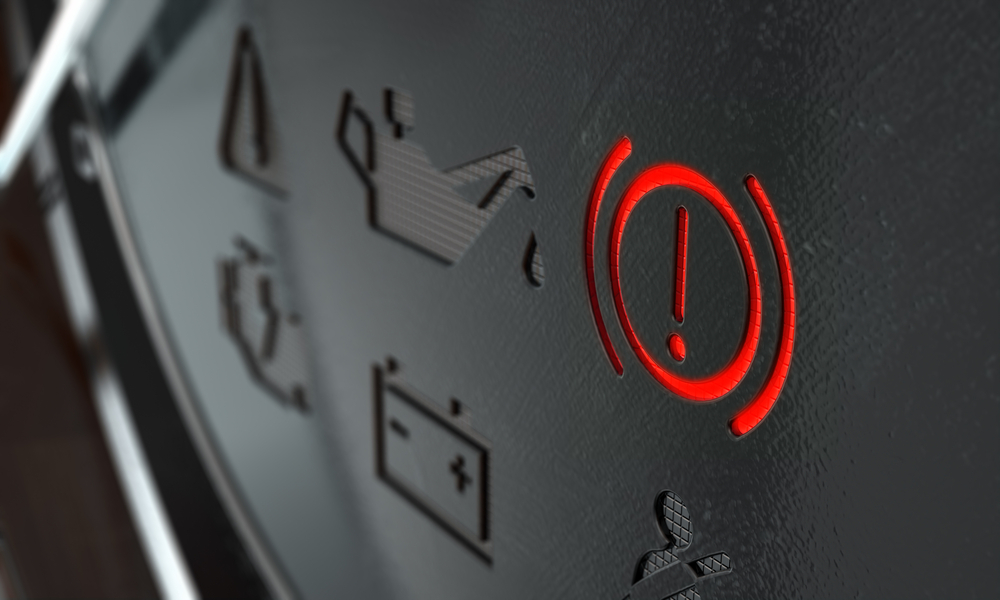Throughout the course of owning your vehicle, you’ve probably witnessed the appearance of many glowing lights on your car’s dashboard. While some of these warning and alert lights are nothing to be concerned with, if you see the Anti-Lock Braking System (ABS) light illuminated, you should start looking for some answers.
The ABS light is designed to alert you when the function of your car’s anti-lock braking system is potentially compromised. There are a variety of reasons that can cause this light to suddenly appear, and it should not be one of those lights you dismiss for as long as possible.
In this article, we will discuss exactly how an anti-lock brake system works, the possible reasons your ABS light may be illuminated, and what to do if you are experiencing this troublesome light on your dashboard.
What Is the ABS Light?
The ABS light is a clear indication that something may be wrong with your car’s overall anti-lock brake system. This light illuminates when the monitoring system senses an issue with the car’s ability to stop you from losing control in the event of emergency braking.
This light is found in the instrument cluster on your dashboard and will typically appear as the letters “ABS” inside of a circle. The light itself is easy to find, especially if it is now illuminated and you have never seen the light on before.
Is It Safe to Drive With the ABS Light On?
While the ABS light doesn’t have a lot of control over your actual brakes and the braking system, it can still be dangerous to drive your vehicle without a working anti-lock brake system. Your brakes will still function, but you are at risk of the wheels locking and losing control of your vehicle if you have to perform any emergency braking or evasive maneuvers.
If you do have to drive with your ABS light on (for instance, if you are taking the car to a mechanic), be sure to brake slowly and steadily, avoiding putting any sudden pressure on the brakes that may cause your wheels to lock.
Reasons Your ABS Light Is On
Below are the most common reasons for your ABS light to be on. Some of them can be diagnosed at home, while others may need a professional to properly identify.
Low Brake Fluid
As an essential part of the ABS, low brake fluid is a common reason behind your ABS light’s illumination. In order to check the brake fluid, open up your hood and look in the brake fluid reservoir. Locate the “full” line and make sure that the fluid is all the way there. If it isn’t, check your owner’s manual for the recommended type of brake fluid and add more in until the “full” line is reached.
Additionally, air in the brake lines could cause the ABS light to appear. In this case, you will need to bleed your brakes, which is a slightly more complicated process.
Faulty Speed Sensor
The wheel speed sensor is located inside the center of the wheel and transmits data to the automated ABS about how fast your car’s wheels are moving.
If this sensor is faulty, which can happen as a result of being covered in grime, dirt, or being damaged by heat from the brakes over time, it will not accurately transmit speed data to the main ABS module. This is what triggers the ABS light to appear.
Bad ABS Module
The ABS module is the automated part of the system that collects speed data and controls the braking reactions. When this module is faulty as a result of corrosion on the connection wires or other wear and tear, the system will not work properly. This triggers the ABS light and may even require a whole new computer in the ABS module in order to fix the issue.
Faulty Bulb Check
The bulb check is a common way to refer to the action of the car lighting up all of the indication lights on the dashboard to ensure the bulbs are working. Occasionally, this system glitches out and may leave the ABS light on.
To rule this out, turn off your car and restart it to see if the ABS light continues to stay on again or if it goes out along with the rest of the dashboard lights. If it stays on, you may need to investigate some of the other reasons to find a culprit.
Weak Battery
A weak battery will often cause havoc with your car’s electrics as it is in the process of dying. If you notice your car’s ABS light occasionally flickering on and off while you’re driving, and you have other symptoms of a weak battery like dim headlights or needing frequent jump starts, it may be time for you to replace your battery.
Chain auto stores can often test your battery to determine if it is bad before you head to a mechanic for a replacement. However, if your battery is bad and you replace it, but the ABS light is still on afterwards, there may be other vehicle issues at play.
Worn Hydraulic Pump
The hydraulic pump and valve are essential in moderating brake fluid pressure to prevent the wheels of your car from locking up. This part of the ABS tends to get worn down over time and years of use, finally triggering the ABS light. This part can also become faulty due to corrosion or dirt build up around the valves.
Blown Fuse
Like most electrical components in your car, the ABS will have its own fuse. If this fuse is loose or blown, it could cause issues with your ABS light turning on. You can check the fuse box to rule out this issue before looking into the more complicated reasons behind the light’s illumination.
What to Do if Your ABS Light Is On

If the ABS light is on, you have a few options. You can try and diagnose the issue yourself, inspecting all the areas we mentioned in our reasons above, or you could take your car straight to the mechanic.
Both methods have their pros and cons, and while you can fix something simple like a blown fuse, low brake fluid, or a bad battery at home, you may need to consult a professional if you think the issue lies in the ABS module or with the hydraulic pump.
You should also know that if your car needs to be emission tested, it will not pass with the ABS light on. It is important to address the reasons behind this light as soon as possible to prevent future issues and the potential failure of the anti-lock brake system.
How Does ABS Work?
The ABS is an automated safety system in your car that has the ability to detect a stop in the rotation of wheels during braking while your car is still in motion. It will then release brake fluid pressure, allowing the wheels to start rotating again.
This prevents the wheels from locking up. The ABS then alternates between releasing and providing pressure on the brakes, ensuring that the wheels stay moving. You may feel a pulsing on the brake pedal as the system does its job.
This action is an essential part of letting you keep control of your vehicle during any instance of skidding while emergency braking. The components of the anti-lock brake system include a speed sensor, a pump, valves, brake fluid, and a controller. Each of these parts is vulnerable to regular deterioration over time, which can cause a malfunction in the ABS and the ABS warning light to come on.
Do All Cars Have ABS?
While ABS has been around since the 1960s, it only started being a mandatory component on cars in the 2012 model year; the National Highway Traffic Safety Administration determined that cars are safer with the addition of anti-lock brake systems.
You more than likely have a car with ABS if it was bought after this year, but if you have an older car and want to determine if you have ABS, there are a few ways you can check.
Determining if Your Car Has an ABS System
The most obvious place to look for indication you have an ABS is on your car’s dashboard. If you do have ABS, you should see the symbol indicating this illuminate briefly when you start your car.
Alternatively, you can look under the hood of the car near the master brake cylinder; you should be able to see the ABS pump here connected to the cylinder via a metal brake line, with other brake lines attached to it.
Additionally, you can get to a position where you have a clear line of the back of the front wheels. Have someone else turn the steering wheel all the way to either the right or the left; you should see a rubber hose connected to the brake caliper and a wire attached to the speed hub sensor. If your car does not have an anti-lock brake system, you will only see the flexible rubber hose that connects to the brake caliper.
The Brake Light vs. the ABS Light

Sometimes, you may see another light on your dashboard that says the word “brake,” or a symbol that looks like an exclamation point in a circle. This light is sometimes confused with the ABS light, but it is actually the light connected to the brake monitoring system, including the parking brake and brake functions.
It is not commonly known that the ABS does not actually control the brakes in your car, and the illumination of the ABS light doesn’t necessarily mean your brakes are bad. However, there are some cases in which worn down brake pads can create excessive heat and damage the speed sensor. Alternatively, worn down brake pads may create metal shards that damage the speed sensor’s wiring or deplete the brake fluid to a level where it triggers the ABS light.
If you see both the ABS and the brake light illuminated on your car’s dashboard, it is very likely that there are some serious issues both with your brakes and with the anti-lock brake system that you need to fix as soon as possible.
The Cost of Fixing ABS Issues
Issues that cause the ABS light in your car to turn on range from quick, cheap fixes to more complex, expensive repairs.
A blown fuse or low brake fluid could cost anywhere between 20 and 50 dollars to repair (just the parts, not including labor if you have a professional do this), while issues like a faulty speed sensor or a bad ABS module could cost between 100 and 550 dollars to repair.
The most uncommon reason behind the ABS light’s appearance, a faulty hydraulic pump or valve, usually costs between 300 and 450 dollars to repair.
Most ABS repair issues will likely not cost you over 500 dollars unless several parts fail at once, which is not common. If you are given an estimate by a professional that greatly exceeds 500 dollars, make sure of what they are replacing and what they claim your anti-lock brake system needs to get it back to working order.
Ensure Your ABS Is Functioning
The anti-lock braking system in your car is one of the most important vehicle safety features today. With its help, you will be able to remain in control if you have to use any type of emergency braking maneuvers.
There are many reasons that could be contributing to your ABS light illuminating, so if you suspect there is a problem with the system, it is a good idea to investigate it immediately to ensure that the ABS is fully functioning.


